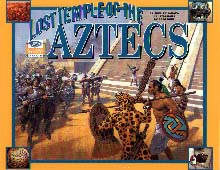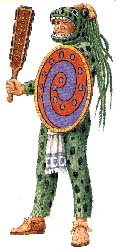|
________________
CM . . . .
Volume VI Number 11 . . . . February 4, 2000
Greg Ruhl, working with Tanaka's version of a powerful and moving story (as he did in The
Buried City of Pompeii (1997) has produced vividly detailed, full page paintings of the key
scenes. Interspersed with Tanaka's swiftly-paced text are dozens of photographs of unearthed
treasures, drawings and sidebars detailing many aspects of Aztec life. Endpapers made up of a
photographic enlargement of the Great Temple's skull rack, where remains of sacrificial victims
were put on display, are a chilling reminder of the Aztecs' practice of human sacrifice. The author
has included a glossary and pronunciation guide for those difficult Aztec words plus a list of
books for young readers who would like to delve further into the lost world of the Aztecs.
Tanaka's imaginative use of the flashback format, her attention to authentic detail and her uncanny
ability to predict the questions a curious 10 or 11 year old would be likely to ask make her an
outstanding writer in the field of information books. Although Lost Temple of the Aztecs may
not be a very useful resource for teachers in the elementary grades, where students will tend to be
looking for books on modern Mexico, it is such a rich and rewarding book, both from a visual and
narrative point of view, that it deserves a place on the school library shelf.
Highly Recommended.
Valerie Nielsen is a retired teacher-librarian living in Winnipeg, MB.
To comment on this title or this review, send mail to cm@umanitoba.ca.
Copyright © the Manitoba Library Association.
Reproduction for personal use is permitted only if this copyright notice
is maintained. Any other reproduction is prohibited without
permission.
Published by
TABLE OF CONTENTS FOR THIS ISSUE - February 4, 2000.
AUTHORS |
TITLES |
MEDIA REVIEWS |
PROFILES |
BACK ISSUES |
SEARCH |
CMARCHIVE |
HOME
|

 Award-winning author Shelley Tanaka has a knack for bringing history's most fascinating stories
to life. Lost Temple of the Aztecs, subtitled What It Was Like When the Spaniards Invaded
Mexico, is her latest book in the popular "I Was There" series. Other titles in this series of
stunningly illustrated information books for middle-years readers have included: On Board the
Titanic (winner of the Silver Birch Award and the Information Book Award in 1997),
Award-winning author Shelley Tanaka has a knack for bringing history's most fascinating stories
to life. Lost Temple of the Aztecs, subtitled What It Was Like When the Spaniards Invaded
Mexico, is her latest book in the popular "I Was There" series. Other titles in this series of
stunningly illustrated information books for middle-years readers have included: On Board the
Titanic (winner of the Silver Birch Award and the Information Book Award in 1997),